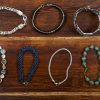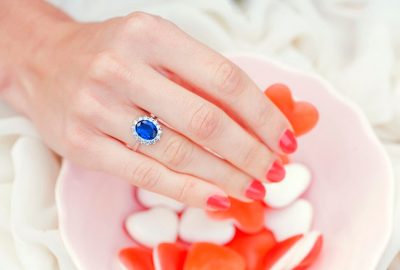Engagement Rings
The Insider Picks team writes about stuff we think you’ll like. Business Insider has affiliate partnerships, so we get a share of the revenue from your purchase.
An engagement ring signifies a huge milestone in a relationship, so it’s a purchase anyone taking that next step wants to get just right.
Not only is it generally one of the largest purchases a person will make — the average American spends $5,871 — it’s typically one that’s made by millennial males who have no idea what they’re doing.
While more and more couples are shopping for engagement rings together, it’s still good to have an idea going in of what you’re looking for and what you want to spend.
We talked with Rony Vardi and Leigh Plessner, the cofounders of a popular, Brooklyn-based jewelry shop and online store called Catbird to find out everything you need to know about purchasing an engagement ring.
Whether the ring in question is a classic diamond solitaire or something a bit less traditional, Vardi and Plessner have you covered with tons of incredible rings to shop and helpful advice. You can also check out Catbird’s engagement ring shopping guide on the company’s website.
Find out how much people are spending, how to determine her ring size, whether you need a GIA certification or not, and more.
And also check out our favorite engagement rings to give and get right now.
Your budget
According to The Knot’s 2015 Real Weddings Study, which surveyed 18,000 US brides and grooms married that year, Americans are spending an average of $5,871 on a ring.
While the rule of spending two to three month’s worth of salary on a ring is long outdated, couples should still seriously consider finances before buying a ring.
Vardi and Plessner urge Catbird customers to spend what works for them: “Find a ring you love that is perfect for your partner, but it’s only half of what you planned on spending? Who cares! That’s more money to buy a beautiful [wedding] band to go with it later. Or, go on vacation. No matter your budget, you’ll be able to find something special.”
The four C’s
One of the terms you see a lot when you start researching engagement rings, and particularly diamonds, is the “four C’s.” Diamonds are graded and priced based on the four C’s. These C’s are: cut, carat, color, and clarity.
They’re important to know because they help you understand the quality of a ring, and they also help determine its price. “While we are of the belief that if a ring is beautiful and feels right, things like this don’t necessarily matter, it’s still good to know what you’re paying for,” said Vardi.
The metal
Typically, you’ll want either gold or platinum for durability.
“We recommend choosing the metal of an engagement ring based on the metal type of her everyday jewelry,” said Plessner.
“For instance, if she wears a lot of silver, she would most likely want a platinum or white gold engagement ring. If she wears yellow gold, stick to that. As for rose gold, we would only recommend it if she wears a lot of rose gold pieces. Rose gold seems to be a real love it, or really, really don’t shade of gold.”
The stone (which doesn’t have to be a diamond)
Diamonds are the most popular stones for engagement rings, but they’re far from the only option.
A worldwide decline of diamond prices in the 1930s led De Beers to begin its world famous marketing campaign, “A diamond is forever.” The campaign helped to cement diamonds’ status as the prime engagement ring stone. Sapphires, rubies, opals, emeralds, moonstones, and pearls (or any combination of all the above) can also make a beautiful ring though. For example, Prince Albert gave Queen Victoria an emerald-studded serpent ring to mark their engagement.
“The key is just knowing your partner’s style and what they expect out of a ring in terms of everyday wear and durability,” Vardi told us. “Some stones are not as durable as diamonds or sapphires, so this is definitely something to take into consideration when choosing a stone.”
Her style
Think about the words you use to describe your partner’s style and what you already know she likes. “Isolating a few touch points about her aesthetic helps when going through ring options and allows you to focus on a smaller group of choices, making the process less overwhelming,” Vardi told us.
If you’re truly stumped, you should consider proposing without a ring or with an obvious substitute, and then embark on the actual ring-shopping experience together.
Ring sizing
Ring sizing is not an exact science. “It depends so much on the shape of one’s fingers, how someone likes to wear their rings, the width of the ring, and so on,” Catbird’s cofounders told us.
“If you can, secretly slip a ring that she wears on her ring finger onto your finger and mark where it hits. If she wears it on her left hand (assuming that is her non-dominant hand), make sure to size down a ¼ size. You can use a ring sizer to see what size the ring is that hits that same mark.”
Things Vardi and Plessner suggest you keep in mind if you do not know her size:
1. After selecting the ring they want to propose with, some customers buy the floor sample for the proposal and then come in afterwards to get sized and order the exact size.
2. Some rings can be re-sized, some cannot be sized at all, and some can only be re-sized a little bit. Ask an experienced jeweler about the style you’re considering if you don’t know her size and they can advise you.
Ultimately, too big is better than too small. You can find more ring sizing information here.
Authentications and certifications
“When it comes to authentications and certifications, it really depends on what you are looking for in a ring,” said Plessner. “For instance, if you have your heart set on a full-carat, brilliant-cut diamond, then you’d want a GIA certification. If you are looking for something more along the lines of a colored diamond, such as a black diamond, a GIA certification is not applicable, as GIA’s grading scale is centered on evaluating a white, brilliant-cut diamond.”
“It is also important to be knowledgeable of where the materials used to make your ring are sourced. At Catbird, we are committed to carrying pieces that use recycled materials and are ethically sourced.”
Return and insurance policies
With a purchase as big as this one, you should really consider getting it insured. “Usually insurance companies will ask that you that provide a receipt of purchase, or sometimes even an appraisal, depending on the kind of coverage you’re looking for,” said Vardi.
Returns are more complicated, especially if you go the custom-made route.
“[Catbird] stands behind all the products that we sell, and if a repair is needed (it can happen), we always send rings back to the original designer so that they can be repaired in the best way. Some rings are returnable, but most custom-ordered rings are final sale. We can always work with customers and show them samples so they are 100% comfortable before having a ring made.”
Vardi and Plessner suggest soliciting help from her best friend, mother, or sibling — someone she may have discussed her preferences with — if you’re not already sure about what sort of ring she wants. “A surprising number of our wedding annex clients have also been tipped off by a Pinterest board.”













































Leave a reply